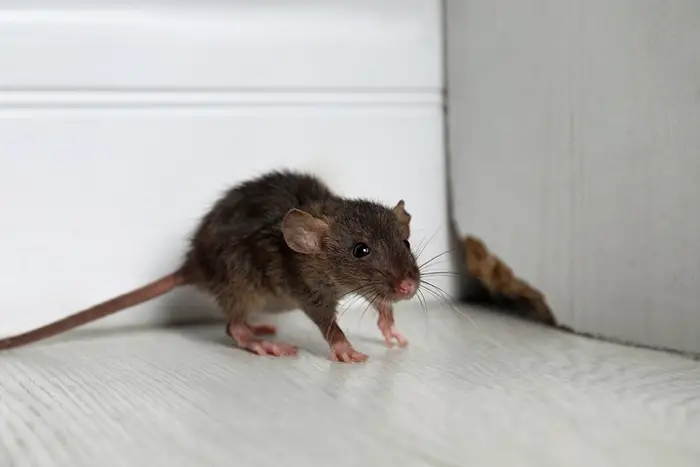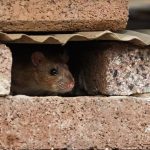How To Find Mice Entry Points – 6 Common Entry Points Explained!
When it comes to dealing with mice infestations, prevention is everything. These tiny creatures can wreak havoc on your property, contaminate your food, and pose health risks. Therefore, identifying and sealing off mice entry points in your home is essential for effective pest control.
So, how to find mice entry points? There are six common places mice may use as entry points. These include
- Cracks in your house’s foundation or weep vents
- Crevices in basements
- Fissures within walls
- Gaps surrounding pipes, cables, and wires
Mice can even squeeze through the tiniest breaches in doors as small as ¼ an inch and windows.
This article will delve more into how to find mice entry points and the preventative measures you should take to ensure the complete elimination of mice.
How Do You Know A Mouse Has Access To A Certain Entry Point?
Mice aren’t the only pests we have to deal with in our homes. Other rodents include rats, moles, and squirrels. As a result, when inspecting for entry points, you should be able to tell whether the hole is from a mouse or another animal.

Here are some tell-tale signs that can help you determine if a mouse has access to the entry point.
1. Size of the Hole
Mouse entry holes are typically small, about the size of a dime or quarter. Because of their small size, they can fit through surprisingly small openings, so keep an eye out for these minute holes in potential entry points.
2. Droppings
Mice leave droppings as they move around your home. Examine the size of the droppings to determine if they are those of a mouse. Rat droppings can be up to 1/2 inch long, whereas mouse droppings are typically 1/4 inch long or less.

Rat droppings are also typically capsule- or spindle-shaped, with rounded ends. Mice droppings, on the other hand, are much smaller and shaped like tiny pellets resembling small grains of rice.
3. Grease Marks
Mice have oily fur, and because they use the same entry point over and over, they can leave greasy smudges along the walls or edges of openings. These marks are often faint and may not be immediately noticeable, but they can be an important indicator of mouse activity.
4. Nests or Nesting Materials
Mice frequently build nests in hidden areas near their entry points. If you find shredded paper, fabric, or insulation materials nearby, mice are most likely using the hole as an entry point.
How to Find Mice Entry Points And How To Solve Them?

Let’s go through some common entry points and the steps to solve the issue.
1. Cracks In The Foundation Or Weep Vents
The foundation of your home can develop cracks or gaps over time, allowing mice easy access. Similarly, weep vents, which are designed to allow moisture to escape, can serve as entry points for these rodents.
- Cover weep vents with fine mesh screens to keep mice out while still allowing proper drainage.
- Additionally, repair small cracks with caulk or concrete. If you notice any larger cracks or gaps, you should have a contractor look them over.
- Strengthening the foundation will not only deter mice but will also contribute to the overall stability and integrity of your home.
2. Cracks In The Basement
Mice can get through cracks in basement walls, especially in older homes. You have a mouse problem if your basement has a strong ammonia odor and nighttime scratching sounds.

I recommend inspecting your basement at night for cracks and gaps. While you walk around the outside, have someone shine a flashlight along the inside wall. Anywhere you can see light shining through is a crack that needs to be filled.
- When addressing these cracks, use steel wool as an effective barrier that mice will struggle to chew through. Stuff steel wool into the gaps and cracks before sealing them with concrete or caulk.
- You can also use expanding foam to fill in the gaps and cracks.
3. Cracks In The Walls
Start at the bottom of your wall to look for cracks. Mice frequently prefer lower-level holes to those higher up. This is not to say that gaps at higher levels should be ignored. Before sealing any wall cracks or gaps, get any mice out of the walls.
Why? Because you might seal in mice in the wall, resulting in a very unpleasant odor once the mice die. This will now require you to cut through the wall to remove the mice. Therefore, set traps near the cracks to lure the mice out.
Once the mice are gone, fill the cracks with steel wool and seal them with concrete. Cover the gap with metal sheets or lath screens if it is large.
4. Gaps Between Pipes, Cables, And Wires

Inspect all areas where pipes, cables, and wires enter or exit your home.
- To effectively seal these gaps around pipes, use a piece of metal to create a barrier.
- Place the metal around the pipe at the wall, making sure it fits snugly to prevent mice from squeezing through.
- Once the metal is in place, use caulk to securely seal it. Expanding foam can also be used to fill gaps around pipes and cables.
- Cover any open pipe ends on the exterior of your home with wire mesh.
5. Gaps In The Doors And Windows
If you can see the light or feel the air getting through the sides of the door when it’s closed, a mouse can squeeze through it.
- Install door sweeps at the bottom of the door to close the gap between the door and the floor.
- Also, use expanding foam insulation to fill any smaller gaps around the door frame.
- When it comes to windows, install weather stripping on all of them. Also, if any of your screens have holes, replace them.
6. Vents And Drains

Begin by inspecting all external vents and drains, including those for the HVAC system, kitchen, bathroom, and laundry room.
- Ensure each vent has a properly fitted and intact screen. If you notice any tears or damage in the existing screens, replace them right away.
- Instead of screens, you can also use mesh wire or hardware cloth to create a barrier around vent openings. For drains, particularly those with grates or openings on the ground level, ensure that the grate is in place and is not sagging.
Does Sealing Off Entry Points Eliminate Your Mice Problem?
No, sealing off entry points does not completely eliminate your mice problem. There are multiple strategies necessary to ensure a mice-free environment. They include:

Landscaping Around Your House
Trim bushes and shrubs near the exterior of your home to reduce rodent hiding places. By maintaining an open and tidy yard, you reduce the appeal of your property to mice looking for shelter.
Sanitation
Mice are drawn to areas with plentiful food sources. So, maintain a clean and tidy kitchen, store food in airtight containers, promptly clean up spills, and regularly take out the trash. This denies mice access to their desired meals, reducing their motivation to stay in your home.
Decluttering
Clutter provides mice with places to hide and build nests. Declutter your living spaces, closets, and storage areas regularly to remove potential nesting spots and deter mice from settling in your home.
Predator Deterrents
Mice can be deterred by introducing natural predators such as cats or dogs. The presence of these animals signals potential danger to rodents, making your home a less appealing environment for them.
Natural Deterrents
Soak cotton balls in eucalyptus or peppermint oil and place them strategically around potential entry points. You can also use mothballs, cloves, or rosemary oil.
Once you’ve identified how mice are entering your home, the next logical step is to eliminate the infestation effectively. Our guide on how to get rid of mice offers comprehensive strategies and solutions to ensure your home remains mouse-free. Moreover, while mice may appear harmless, it’s crucial to understand the potential risks they pose, including the possibility of bites. For more insights into this topic and how to handle it, check out our detailed article on mouse bites.FAQs
These are other related questions homeowners ask about this topic.
Q1. How can I tell if the mice infestation has been successfully eliminated?
After sealing off entry points, keep an eye out for signs of mice activity. If there are no new droppings, gnaw marks, or sightings, your efforts have been successful.
Q2. Can mice enter my home through the chimney?
Yes, mice can use vents, soffit openings, and even chimneys as potential entry points. Inspecting these areas and ensuring they are adequately sealed off with mesh screens or hardware cloth to prevent mice from gaining access is crucial.
Q3. Can mice use toilet openings to come into my house?
Mice cannot enter your home through toilet holes. The plumbing system, including the toilet, prevents waste or water from backing up into your home. The pipes connect to the sewage system or septic tank, which is usually a closed and inaccessible system to rodents.
Conclusion
Identifying and addressing mice entry points is an essential part of effective pest control and maintaining a harmonious living environment. We should know of the common entry points they use to empower us to take proactive measures against infestations.
Conduct systematic inspections of both the exterior and interior of our homes. Once you successfully locate an entry point, seal it off with either caulk, cement, expanding foam, or wire mesh. The method you use to seal the hole depends on where the hole is and how large it is.




